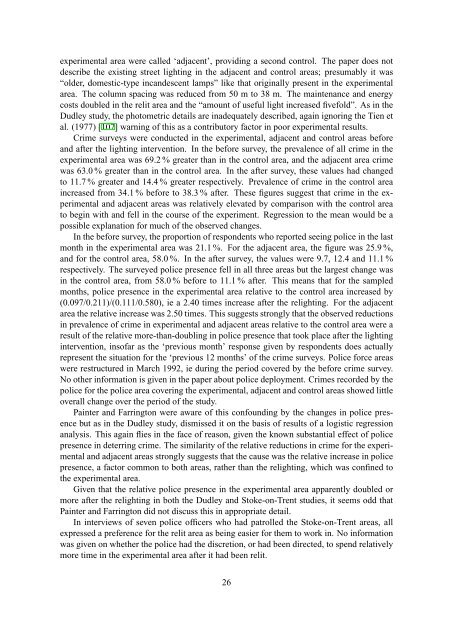outdoor lighting and crime, part 1 - Astronomical Society of Victoria
outdoor lighting and crime, part 1 - Astronomical Society of Victoria
outdoor lighting and crime, part 1 - Astronomical Society of Victoria
Create successful ePaper yourself
Turn your PDF publications into a flip-book with our unique Google optimized e-Paper software.
experimental area were called ‘adjacent’, providing a second control. The paper does not<br />
describe the existing street <strong>lighting</strong> in the adjacent <strong>and</strong> control areas; presumably it was<br />
“older, domestic-type inc<strong>and</strong>escent lamps” like that originally present in the experimental<br />
area. The column spacing was reduced from 50 m to 38 m. The maintenance <strong>and</strong> energy<br />
costs doubled in the relit area <strong>and</strong> the “amount <strong>of</strong> useful light increased fivefold”. As in the<br />
Dudley study, the photometric details are inadequately described, again ignoring the Tien et<br />
al. (1977) [107] warning <strong>of</strong> this as a contributory factor in poor experimental results.<br />
Crime surveys were conducted in the experimental, adjacent <strong>and</strong> control areas before<br />
<strong>and</strong> after the <strong>lighting</strong> intervention. In the before survey, the prevalence <strong>of</strong> all <strong>crime</strong> in the<br />
experimental area was 69.2 % greater than in the control area, <strong>and</strong> the adjacent area <strong>crime</strong><br />
was 63.0 % greater than in the control area. In the after survey, these values had changed<br />
to 11.7 % greater <strong>and</strong> 14.4 % greater respectively. Prevalence <strong>of</strong> <strong>crime</strong> in the control area<br />
increased from 34.1 % before to 38.3 % after. These figures suggest that <strong>crime</strong> in the experimental<br />
<strong>and</strong> adjacent areas was relatively elevated by comparison with the control area<br />
to begin with <strong>and</strong> fell in the course <strong>of</strong> the experiment. Regression to the mean would be a<br />
possible explanation for much <strong>of</strong> the observed changes.<br />
In the before survey, the proportion <strong>of</strong> respondents who reported seeing police in the last<br />
month in the experimental area was 21.1 %. For the adjacent area, the figure was 25.9 %,<br />
<strong>and</strong> for the control area, 58.0 %. In the after survey, the values were 9.7, 12.4 <strong>and</strong> 11.1 %<br />
respectively. The surveyed police presence fell in all three areas but the largest change was<br />
in the control area, from 58.0 % before to 11.1 % after. This means that for the sampled<br />
months, police presence in the experimental area relative to the control area increased by<br />
(0.097/0.211)/(0.111/0.580), ie a 2.40 times increase after the re<strong>lighting</strong>. For the adjacent<br />
area the relative increase was 2.50 times. This suggests strongly that the observed reductions<br />
in prevalence <strong>of</strong> <strong>crime</strong> in experimental <strong>and</strong> adjacent areas relative to the control area were a<br />
result <strong>of</strong> the relative more-than-doubling in police presence that took place after the <strong>lighting</strong><br />
intervention, ins<strong>of</strong>ar as the ‘previous month’ response given by respondents does actually<br />
represent the situation for the ‘previous 12 months’ <strong>of</strong> the <strong>crime</strong> surveys. Police force areas<br />
were restructured in March 1992, ie during the period covered by the before <strong>crime</strong> survey.<br />
No other information is given in the paper about police deployment. Crimes recorded by the<br />
police for the police area covering the experimental, adjacent <strong>and</strong> control areas showed little<br />
overall change over the period <strong>of</strong> the study.<br />
Painter <strong>and</strong> Farrington were aware <strong>of</strong> this confounding by the changes in police presence<br />
but as in the Dudley study, dismissed it on the basis <strong>of</strong> results <strong>of</strong> a logistic regression<br />
analysis. This again flies in the face <strong>of</strong> reason, given the known substantial effect <strong>of</strong> police<br />
presence in deterring <strong>crime</strong>. The similarity <strong>of</strong> the relative reductions in <strong>crime</strong> for the experimental<br />
<strong>and</strong> adjacent areas strongly suggests that the cause was the relative increase in police<br />
presence, a factor common to both areas, rather than the re<strong>lighting</strong>, which was confined to<br />
the experimental area.<br />
Given that the relative police presence in the experimental area apparently doubled or<br />
more after the re<strong>lighting</strong> in both the Dudley <strong>and</strong> Stoke-on-Trent studies, it seems odd that<br />
Painter <strong>and</strong> Farrington did not discuss this in appropriate detail.<br />
In interviews <strong>of</strong> seven police <strong>of</strong>ficers who had patrolled the Stoke-on-Trent areas, all<br />
expressed a preference for the relit area as being easier for them to work in. No information<br />
was given on whether the police had the discretion, or had been directed, to spend relatively<br />
more time in the experimental area after it had been relit.<br />
26
















